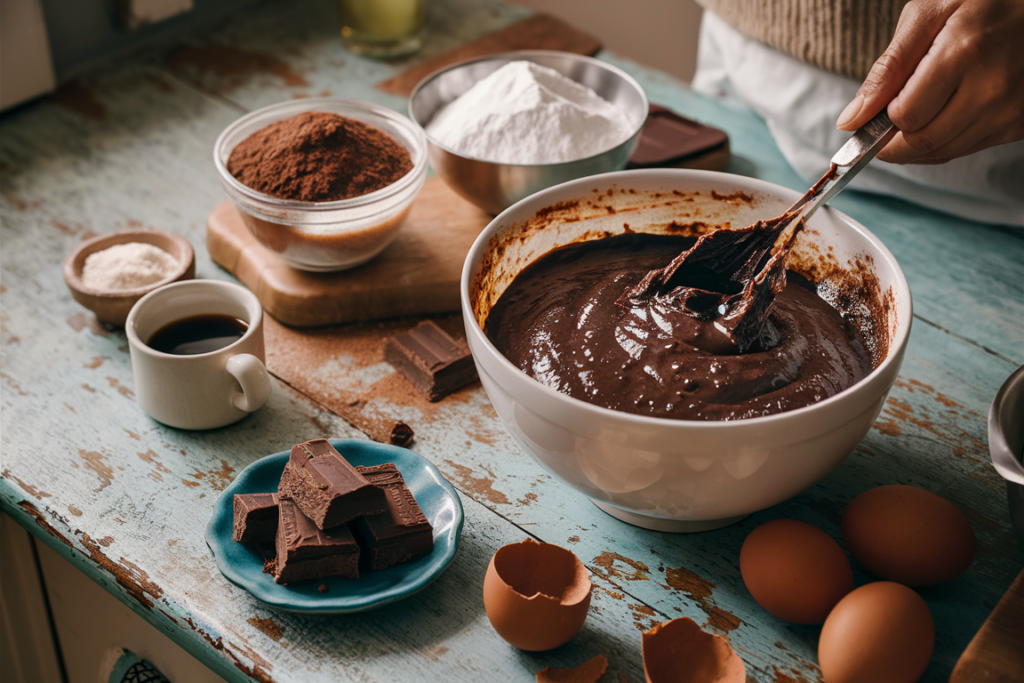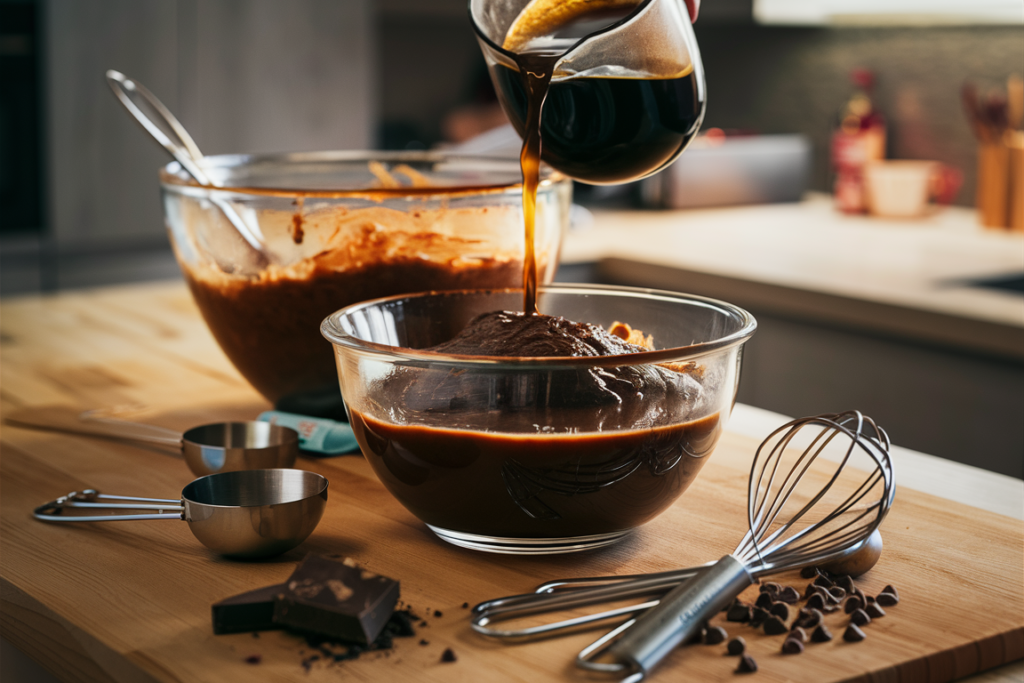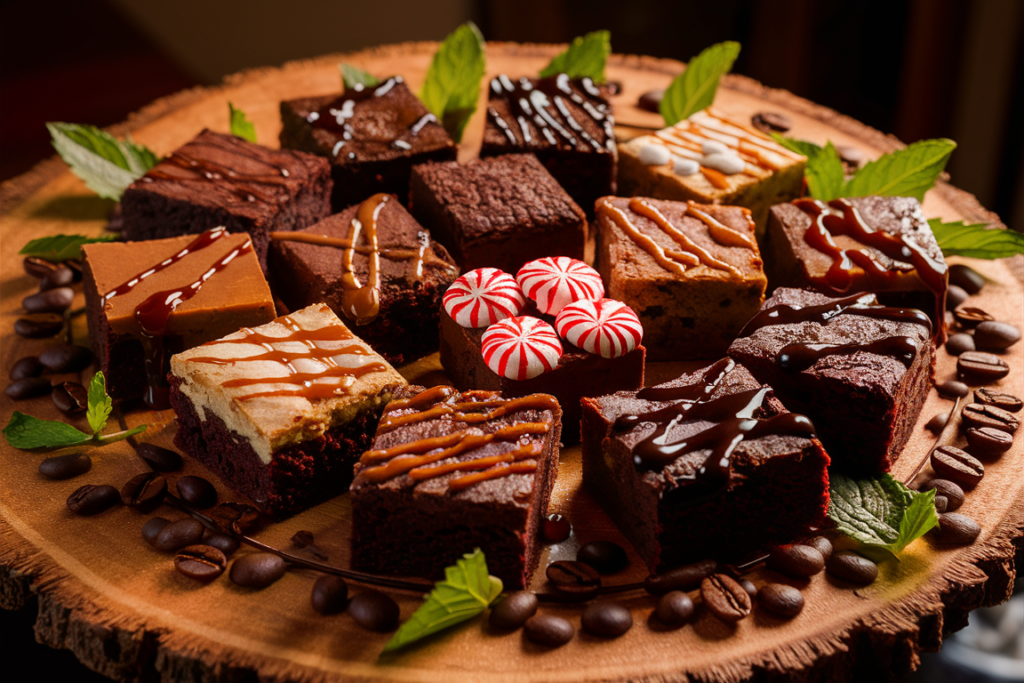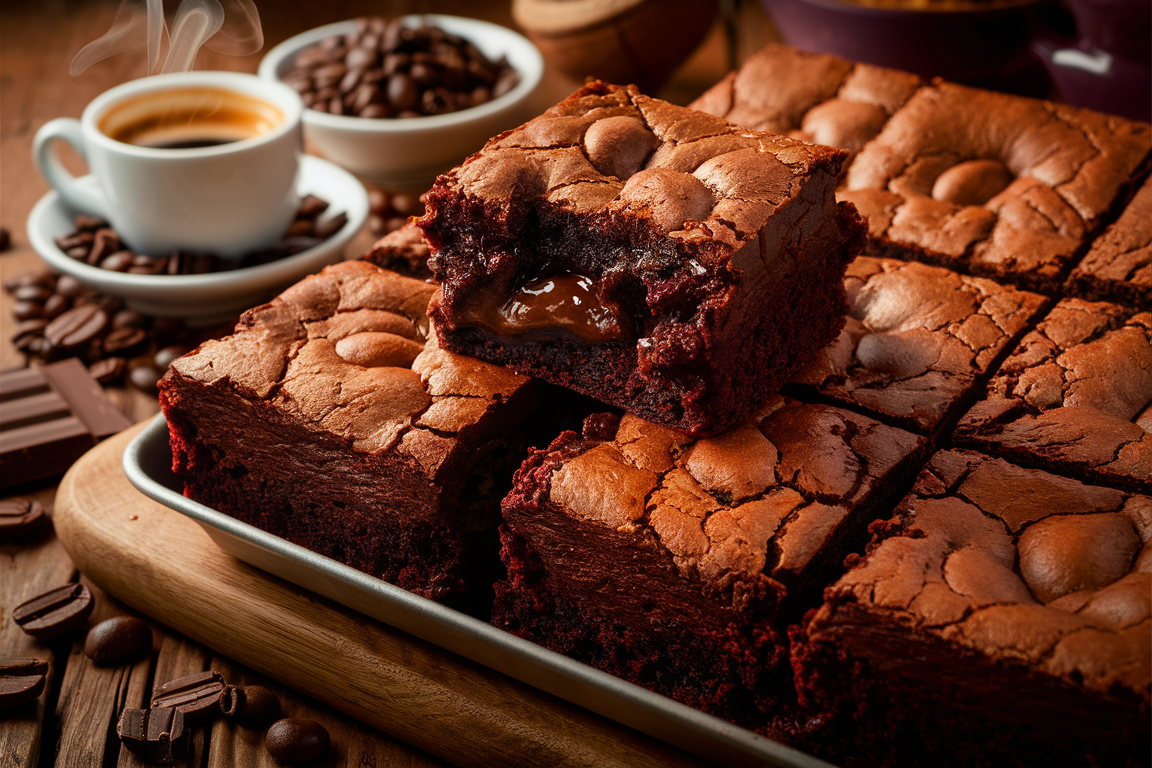Part 1: Understanding Brownie Mix and Its Ingredients

1. What Is Brownie Mix?
Brownie mix is a convenient blend of ingredients designed to streamline the baking process. Typically, it includes several key components, such as:
- Flour: The base that provides structure.
- Cocoa Powder: For rich chocolate flavor.
- Sugar: Adds sweetness and balances bitterness.
- Leavening Agents: Such as baking powder for a light texture.
- Preservatives: To extend shelf life.
Some premium mixes may also feature add-ins like chocolate chips or flavor enhancers. Moreover, by using a pre-made mix, bakers can effortlessly skip the measuring of individual components. As a result, they can ensure consistent results every time
Learn more about the science behind ingredients in this detailed guide to brownie basics.
2. Purpose of Water in Brownie Mix
Water serves a fundamental purpose in brownie recipes by:
- Activating Leavening Agents: Water reacts with baking powder or soda, helping brownies rise.
- Hydrating Dry Ingredients: Flour and cocoa require moisture to bind effectively.
- Dissolving Sugar: Ensures a smooth, even batter.
This simple liquid may seem insignificant, but it’s vital for achieving a cohesive and bake-ready batter.
3. The Science of Liquid in Baking
The liquid component of any baked good—whether it’s water, milk, or coffee—has a multi-dimensional impact. It affects:
- Texture: Determines chewiness or fudginess in brownies.
- Consistency: Helps the batter spread evenly in the pan.
- Flavor Distribution: Ensures the chocolate and sugar dissolve fully.
Switching from water to another liquid, like coffee, introduces new flavor complexities while maintaining these essential baking functions.
4. Coffee as a Substitute for Water
Replacing water with coffee in your brownie mix, for instance, can elevate the dessert to new flavor heights. Additionally, coffee enhances the natural bitterness of chocolate, thereby creating a deeper and more robust flavor profile.
Key benefits include:
- A subtle mocha flavor that pairs perfectly with chocolate.
- Enhanced aroma and a gourmet twist.
- Improved texture, as coffee contains oils that may slightly enrich the batter.
Using coffee instead of water is a simple swap that has a big culinary payoff.
5. Types of Coffee to Use in Brownie Mix
The type of coffee you use can drastically affect the end result:
- Espresso: Provides an intense, concentrated flavor ideal for mocha lovers.
- Cold Brew: Offers a smoother, less acidic taste.
- Instant Coffee: A quick and easy option that still enhances flavor.
Choose based on your flavor preference and available brewing tools. Cold brew, for instance, can add depth without bitterness, while espresso packs a punch for bold flavors.
6. Measuring Coffee for Substitution
When using coffee as a substitute for water in brownie mix, stick to these general guidelines:
- Use the same quantity as the water recommended on the box.
- For a stronger flavor, replace only half the water with coffee initially, then adjust based on your taste.
This method ensures the batter consistency remains correct while experimenting with flavor intensity.
7. How Coffee Affects Sweetness Levels
Coffee, particularly dark roast or espresso, introduces a slight bitterness to brownies. This contrast can balance overly sweet mixes and enhance the chocolate’s depth. To prevent an imbalance:
- Use a mix with a higher sugar content.
- Add a tablespoon of honey or brown sugar if the result feels too bitter.
The right balance creates a dessert that’s neither cloyingly sweet nor overly bitter.
8. Enhancing Chocolate Flavor with Coffee
Interestingly, chocolate and coffee share several chemical flavor compounds, which makes them a match made in dessert heaven. Furthermore, adding coffee can:
- Intensify the rich, chocolatey notes.
- Create a more complex, layered taste.
- Reduce the need for extra sugar by highlighting cocoa’s natural sweetness.
The synergy of these two ingredients ensures a decadent, unforgettable brownie.
9. Nutritional Impact of Coffee in Brownies
Adding coffee to brownies introduces minor caloric changes and a touch of caffeine. Consider:
- Calorie Count: Brewed coffee is low in calories, so it won’t significantly alter the nutrition facts.
- Caffeine: A serving of coffee brownies may have a slight caffeine kick, especially if espresso is used.
For those who are sensitive to caffeine, opting for decaffeinated coffee is an excellent alternative. This way, you can still enjoy the rich flavor without experiencing the buzz.
10. Alternatives to Coffee for Flavor Variations
Not a fan of coffee? No problem! Substitute water with other liquids to customize your brownies:
- Milk: Adds creaminess and richness.
- Juice: Orange juice pairs beautifully with dark chocolate for a fruity twist.
- Flavored Extracts: Vanilla or almond extracts can be mixed into the water for subtle flavor changes.
These swaps allow for endless creative brownie combinations to suit any palate.
Part 2: Step-by-Step Guide to Adding Coffee to Brownie Mix

11. Choosing the Right Coffee Strength
Selecting the ideal coffee strength is key to balancing the flavors in your brownies. Consider the following options:
- Mild Brew: Perfect for a subtle coffee flavor that doesn’t overpower the chocolate.
- Medium Roast: A balanced choice that enhances chocolate without excessive bitterness.
- Dark Roast or Espresso: Adds an intense, rich coffee profile and is ideal for bold mocha brownies.
If you’re new to coffee-infused baking, start with a medium roast and adjust in future batches based on your preferences.
12. Preparing the Coffee
Before adding coffee to your brownie mix, proper preparation is crucial to achieving the best results. Follow these steps:
- Brew Fresh Coffee: Use your preferred method, such as a drip coffee maker, French press, or espresso machine.
- Cool It Down: Let the brewed coffee cool to room temperature. Adding hot coffee may prematurely activate the leavening agents in your mix, affecting the texture.
- Measure Accurately: Use the exact amount specified in the brownie mix instructions, substituting water with coffee one-to-one.
For those pressed for time, instant coffee dissolved in hot water can be a quick alternative.
13. Mixing Coffee into the Batter
Incorporating coffee into your brownie mix requires gentle but thorough mixing:
- Combine Dry Ingredients First: If you’re using a custom mix, blend all the dry ingredients before adding liquids.
- Add Coffee Slowly: Gradually pour in the coffee while mixing to avoid lumps.
- Avoid Overmixing: Excessive mixing can lead to dense brownies. Stir just until all ingredients are combined.
By evenly blending coffee into the batter, you ensure a uniform flavor in every bite.
14. Adjusting Baking Time and Temperature
Using coffee as a liquid may slightly alter the baking dynamics of your brownies:
- Watch the Edges: Coffee can darken the edges more quickly, so monitor closely.
- Adjust Time: Reduce baking time by 2-3 minutes initially, especially for recipes with added moisture.
- Temperature Stability: Stick to the temperature recommended on the box unless adding extra wet ingredients.
To avoid overbaking, test the brownies for doneness 5 minutes before the suggested time.
15. Adding Additional Ingredients
Elevate your coffee brownies with creative add-ins. Here are some options:
- Chocolate Chips: Boost the chocolate flavor and create gooey pockets of sweetness.
- Nuts: Walnuts or pecans add texture and complement the mocha profile.
- Spices: A pinch of cinnamon or chili powder pairs beautifully with coffee and chocolate.
Adding these extras lets you customize your brownies while enhancing their overall appeal.
16. Testing for Doneness with Coffee Brownies
Knowing when coffee brownies are perfectly baked is critical. Use these methods:
- Toothpick Test: Insert a toothpick into the center. If it comes out with a few moist crumbs, the brownies are done.
- Visual Cues: Look for a slightly puffed surface with a shiny, crackled top.
- Touch Test: Gently press the center. It should feel set but slightly soft.
Remember, brownies often continue to cook slightly after being removed from the oven, so err on the side of underbaking for fudgier results.
17. Common Mistakes to Avoid
Avoid these pitfalls when baking coffee brownies:
- Using Hot Coffee: As mentioned earlier, hot liquid can alter the texture.
- Overpowering the Flavor: Too much coffee can mask the chocolate, leading to unbalanced flavors.
- Overmixing the Batter: Creates dense, tough brownies.
To maintain the perfect texture and flavor, stick to the recommended ratios and mixing techniques.
18. Vegan and Dairy-Free Options
You can easily adapt coffee brownies for vegan or dairy-free diets:
- Use Plant-Based Coffee Creamers: Almond, oat, or coconut creamer can replace water and enhance flavor.
- Egg Substitutes: Flaxseed or chia seeds soaked in water can act as a binding agent.
- Vegan Chocolate: Ensure any added chocolate is dairy-free.
These substitutions allow everyone to enjoy delicious coffee-infused brownies without dietary restrictions.
19. Storing Coffee Brownies
Proper storage keeps your coffee brownies moist and flavorful:
- Room Temperature: Store in an airtight container for up to 3 days.
- Refrigeration: Extends freshness to a week but may firm up the texture.
- Freezing: Wrap individual pieces tightly in plastic wrap and store in a freezer-safe bag for up to 3 months.
To revive stored brownies, microwave them for a few seconds to restore their softness.
20. Serving Suggestions and Pairings
Enhance your coffee brownie experience with these serving ideas:
- Beverages: Pair with a glass of milk, a cup of hot coffee, or a creamy latte.
- Toppings: Add whipped cream, a scoop of vanilla ice cream, or a drizzle of caramel sauce.
- Plating: Dust with powdered sugar or cocoa powder for a gourmet presentation.
Serving brownies warm highlights their rich, gooey texture and enhances the coffee-chocolate combination.
Part 3: Variations, Benefits, and Troubleshooting

21. Popular Coffee Brownie Variations
Coffee brownies are highly versatile, and experimenting with variations can elevate your dessert game. Here are some fan-favorite ideas:
- Mocha Brownies: Add a teaspoon of cocoa powder and espresso for an intense mocha flavor.
- Caramel Macchiato Brownies: Drizzle caramel sauce over the batter before baking.
- Peppermint Mocha Brownies: Mix in crushed peppermint candies or a drop of peppermint extract.
- Tiramisu-Inspired Brownies: Layer mascarpone cheese between two brownie layers and soak in coffee syrup.
Each variation creates a unique twist, making your coffee brownies distinctive and unforgettable.
22. Benefits of Adding Coffee to Brownie Mix
Including coffee in your brownie mix offers several benefits:
- Flavor Enhancement: Coffee intensifies the chocolate flavor, creating a gourmet taste.
- Aromatic Appeal: The combination of coffee and chocolate provides a rich, irresistible aroma.
- Customizability: You can adjust the coffee’s strength to match your flavor preference.
These benefits make coffee an ideal addition for creating luxurious and bakery-quality brownies.
23. Addressing Flavor Imbalances
Balancing the flavors in coffee brownies is essential. If your brownies taste too bitter or sweet, here’s how to fix them:
- Too Bitter: Add a tablespoon of sugar or serve with whipped cream for balance.
- Too Sweet: Use a dark roast coffee or sprinkle a touch of sea salt on top.
- Overpowering Coffee: Dilute the coffee or use half water and half coffee in the next batch.
Making small adjustments ensures a harmonious and delightful flavor profile.
24. Using Decaffeinated Coffee
For those sensitive to caffeine, decaffeinated coffee is the perfect solution. Not only does decaf provide the same rich coffee flavor without the stimulating effects, but it also serves as a family-friendly option, making it ideal for children or individuals who wish to avoid caffeine altogether
Whether using decaf espresso or instant coffee, the results will still be flavorful and indulgent.
25. Incorporating Coffee-Flavored Products
In addition to brewed coffee, try incorporating coffee-flavored ingredients for added depth:
- Instant Coffee Granules: Stir directly into the batter for bursts of coffee flavor.
- Coffee Liqueur: Adds richness and a hint of sophistication.
- Coffee Extract: A concentrated option for precise flavor control.
These additions complement brownies and amplify the coffee-chocolate synergy.
26. Feedback from Home Bakers
Home bakers rave about the impact of coffee in brownie recipes. Real-life testimonials highlight:
- Flavor Complexity: Many report that coffee brownies taste more luxurious than standard brownies.
- Ease of Use: Swapping water for coffee is a simple, no-fuss method.
- Crowd-Pleasing Appeal: Coffee brownies often become the highlight of parties or gatherings.
If you’re looking for an easy way to wow guests, coffee brownies are a go-to choice.
27. Adjusting Recipes for Dietary Needs
For those with dietary restrictions, coffee brownies can be tailored to meet various needs:
- Sugar-Free: Use a sugar substitute like erythritol or stevia.
- Gluten-Free: Replace regular flour with almond or coconut flour.
- Low-Calorie: Use black coffee instead of creamer or milk.
With these adjustments, you can enjoy brownies without compromising your dietary goals.
28. Experimenting with Other Liquids
While coffee is a fantastic choice, it isn’t the only liquid that can transform brownies. Instead, consider trying these alternatives to achieve unique and exciting flavors:
- Tea: Earl Grey or chai adds a fragrant, spiced note.
- Hot Chocolate: Boosts the chocolate flavor and creates a creamier texture.
- Cola: Adds sweetness and a subtle caramel undertone.
Experimenting with liquids lets you create one-of-a-kind desserts that stand out.
29. Advanced Troubleshooting
Occasionally, issues may arise when making coffee brownies. Here’s how to address them:
- Overly Dense Texture: Use less coffee or incorporate a pinch of baking soda.
- Dry Brownies: Add an extra tablespoon of oil or butter to maintain moisture.
- Uneven Flavor: Mix the batter more thoroughly to distribute the coffee evenly.
These fixes ensure your coffee brownies turn out perfectly every time.
30. Final Thoughts and Recommendations
Coffee brownies offer a delicious fusion of chocolate and coffee flavors, which undoubtedly elevate any dessert table. Moreover, by experimenting with different coffee types, creative add-ins, and unique variations, you can effortlessly craft brownies that perfectly suit your unique tastes.
For best results, always:
- Use fresh, high-quality coffee.
- Balance sweetness and bitterness.
- Monitor baking times closely to avoid overcooking.
Whether for a casual treat or a special occasion, coffee brownies are sure to impress.
More FAQs
- Can I use instant coffee in brownies?
Yes, dissolve instant coffee in water for a quick and flavorful substitute. - What type of coffee works best for brownies?
Medium or dark roast coffee enhances chocolate flavors without overpowering. - Can I add coffee to gluten-free brownie mix?
Absolutely! Coffee works well with gluten-free mixes. - How do I adjust sweetness when using coffee?
Add a touch of sugar or honey to balance any added bitterness. - Is decaf coffee effective in brownies?
Yes, decaf delivers the same rich flavor without caffeine. - Can I use flavored coffee?
Yes, hazelnut or vanilla-flavored coffee adds unique profiles to brownies. - Should I change baking times when adding coffee?
Check for doneness a few minutes early, as coffee may alter baking dynamics. - What’s the best way to store coffee brownies?
Use an airtight container at room temperature or freeze for longer storage. - Can I add cream or milk to my coffee for brownies?
Yes, this can create a richer, creamier batter. - Are coffee brownies suitable for kids?
Yes, but opt for decaf to minimize caffeine exposure.

